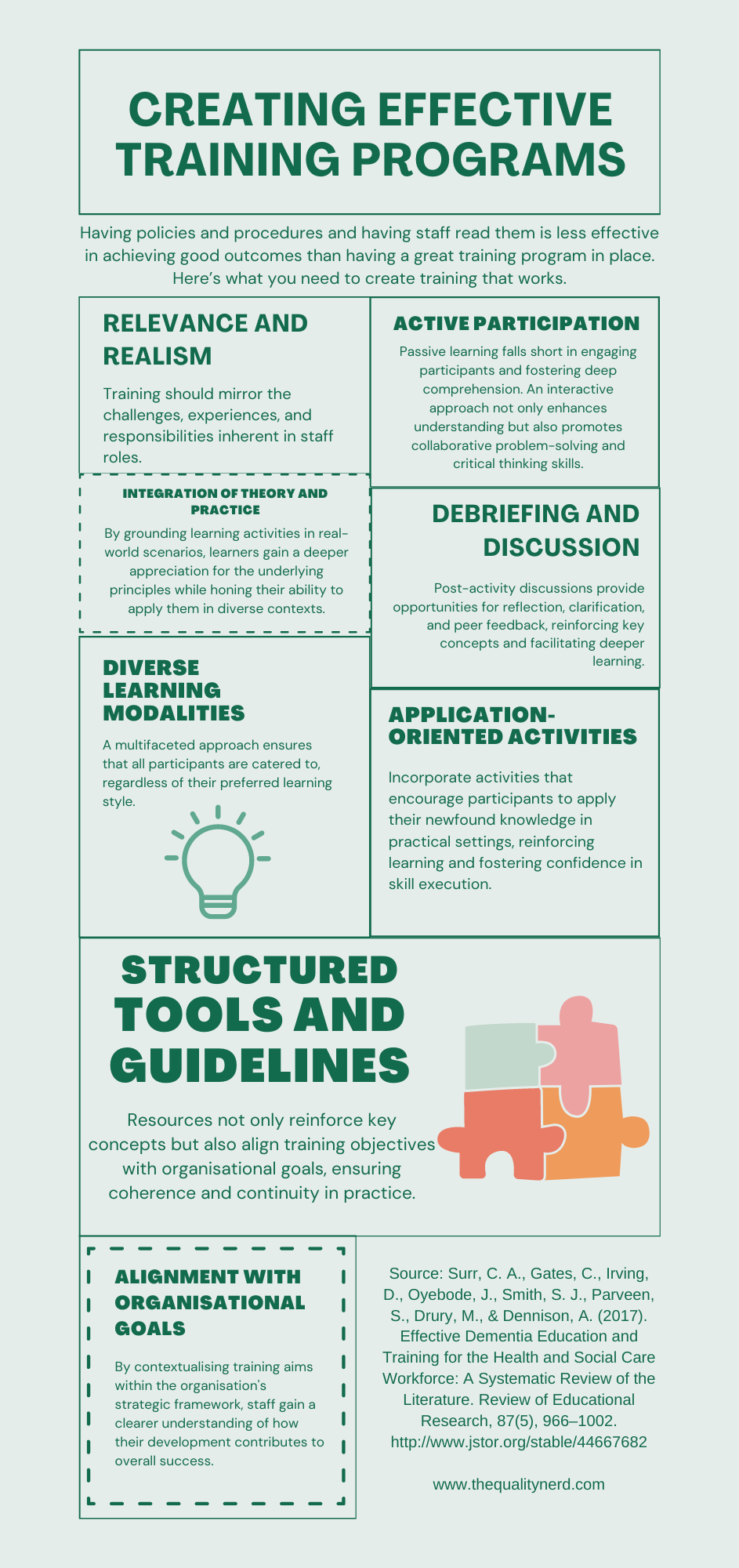Creating Effective Training Programs for the Human Services Sector
I was assisting a couple of NDIS and Aged Care organisations over summer and needed to do a deep dive into topics like ‘what makes a good policy’ and ‘what makes quality standards stick’, and the research proved really interesting. There are a lot of demands on staff in the human services sector, and it seems like the demands we place on staff are increasing all the time. The level of skills and knowledge that is required to keep both our staff and clients safe and well grows, as do the demands of regulators on organisations overall. A lot of organisations manage these risks by developing policies and procedures and expect staff to read, understand, and apply these with little to no contact from management. This allows organisations to keep resources available and training costs low. It is understandable in the current economic climate that organisations would seek cost and resource efficiency in any way possible. However, the evidence is clear that the hands-off approach is ineffective in ensuring staff competency. In short, having policies and procedures is less effective in achieving good outcomes than having a great training program in place.
The efficacy of training and education programs hinges on their relevance, engagement, and adaptability to meet the diverse needs of learners. Gone are the days of one-size-fits-all approaches; instead, a tailored, multifaceted strategy is essential for fostering meaningful growth and skill acquisition. Let's delve into the key elements that make training initiatives truly effective.
Relevance and Realism: Effective training programs resonate with learners when they mirror the challenges, experiences, and responsibilities inherent in their roles. Adopting a tailored approach ensures that the content is directly applicable to their day-to-day tasks, fostering a deeper understanding and retention of knowledge.
Active Participation: Passive learning often falls short in engaging participants and fostering deep comprehension. Active participation encourages learners to immerse themselves in the material, whether through group discussions, case studies, or hands-on exercises. This interactive approach not only enhances understanding but also promotes collaborative problem-solving and critical thinking skills.
Integration of Theory and Practice: A successful training program strikes a balance between theoretical knowledge and practical application. By grounding learning activities in real-world scenarios, learners gain a deeper appreciation for the underlying principles while honing their ability to apply them in diverse contexts.
Debriefing and Discussion: Experiential and simulation-based learning are invaluable tools for skill development. However, their effectiveness is maximized when accompanied by structured debriefing sessions. These post-activity discussions provide opportunities for reflection, clarification, and peer feedback, reinforcing key concepts and facilitating deeper learning.
Diverse Learning Modalities: Recognizing that individuals have varied learning preferences, effective programs employ a mix of learning modalities, including face-to-face interactions, practical demonstrations, and interactive workshops. This multifaceted approach ensures that all participants are catered to, regardless of their preferred learning style.
Application-Oriented Activities: Learning doesn't end in the classroom; it extends to the application of acquired skills in real-world scenarios. Effective training programs incorporate activities that encourage participants to apply their newfound knowledge in practical settings, reinforcing learning and fostering confidence in skill execution.
Structured Tools and Guidelines: Providing staff with structured tools, methods, or practice guidelines serves as a roadmap for translating learning into action. These resources not only reinforce key concepts but also align training objectives with organisational goals, ensuring coherence and continuity in practice.
Alignment with Organisational Goals: Finally, effective training initiatives are strategically aligned with the broader objectives and direction of the organisation. By contextualising training aims within the organisation's strategic framework, staff gain a clearer understanding of how their development contributes to overall success.
Effective training and education programs are characterised by their relevance, engagement, adaptability, and alignment with organisational objectives. By incorporating these key elements into the design and delivery of training initiatives, organisations can cultivate a culture of continual learning and development, empowering their staff to thrive in our complex environment, and ultimately deliver high quality, safe services to clients.
Thanks for reading,
Clarisa
P.S - did you know I create infographics like the one below to help your organisation distil policies and procedures into more user friendly information? Contact me for more details on how I can help you with this!

